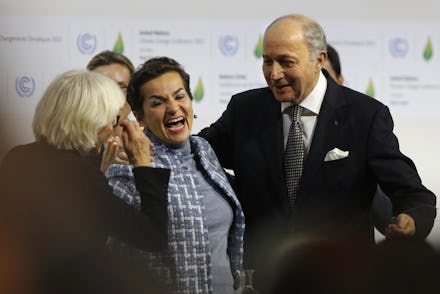Negotiators Reach Historic Climate Deal in Paris — Here's What Is Actually Inside

Negotiators at the 2015 United Nations Climate Change Conference in Paris, representing more than 190 countries around the globe, have reached a historic climate deal.
CNN reports the agreement's final draft, the outcome of "years of buildup and weeks of negotiations," would attempt to halt global warming at the widely agreed-upon limit of a planet Earth no more than 2 degrees Celsius (3.6 degrees Fahrenheit) warmer on average than pre-industrial limits. According to CNN, it sets a more ambitious but extraordinarily difficult-to-achieve secondary goal of halting warming at 1.5 degrees Celsius "if possible."
While the accord will still need to be ratified by each of the U.N.'s member states, here's what's inside.
Halting warming at 2 degrees Celsius, or lower. This key goal is necessary because climate and environmental scientists widely agree that beyond that point, the risk of catastrophic climate events such as mega-droughts, rising oceans and major disruption to the planet's ecology increases dramatically. Above 2 degrees Celsius, scientists warn, things could get very bad indeed.
If the planet continues on its current path, entire regions of the world could become so hot in the summer that heat waves alone would kill many people living there — such as in the Gulf Region, which a team of scientists concluded earlier this year could become largely unlivable by the end of the century if emissions continue on their current course.
However, the paper noted the measures set forth in the agreement are likely only to reach a 3 degrees Celsius cap on global warming in reality, though the stretch goal "of 1.5 could be a watershed."
Fossil fuels declared on their way out. The draft agreement requires all signatories to "reach global peaking of greenhouse gas emissions as soon as possible, recognizing that peaking will take longer for developing country parties, and to undertake rapid reductions thereafter," according to the New York Times.
To reach the warming goals, the deal essentially requires all signing countries to collectively move away from fossil fuels, according to the White House.
The Obama administration issued a press release to Mic saying the Paris agreement would send "a strong signal to the private sector that the global economy is moving towards clean energy."
"This marks the end of the era of fossil fuels. There is no way to meet the targets laid out in this agreement without keeping coal, oil and gas in the ground," 350.org executive director May Boeve told Agence France-Presse. "The text should send a clear signal to fossil fuel investors: divest now."
However, the deal does not commit any individual countries to hit any specific emissions targets — the peak as quickly as possible goal is designed to allow developing countries flexibility in contributing to the global goal.
Sets a $100 billion annual target for global spending to avert catastrophic climate change. Also according to the New York Times, the draft agreement sets a "new collective quantified goal" of $100 billion each year of international spending on the climate. However, it does not require any countries to contribute a set numerical amount towards that goal.
This total is nowhere near the full amount of financing that will be required globally. According to Bloomberg, the International Energy Agency believes total worldwide spending will need to reach $16.5 trillion a year between 2015 and 2030 to satisfy all requirements needed to meet the 2 degree target. But Bloomberg also reported 2014's global spending was around $391 billion.
Five-year reviews. Starting in 2023 and then every five years after, the signatories of the agreement will be required to meet, review their emissions targets and adopt more expansive plans to meet them. One prior interim meeting will take place in 2018.
"The Conference of the Parties serving as the meeting of the Parties to the Paris Agreement shall undertake its first global stockade in 2023 and every five years thereafter unless otherwise decided by the Conference of the Parties serving as the meeting of the Parties to the Paris Agreement," reads the draft deal, according to Mashable.
These five-year reviews are necessary to ensure all countries involved do not renege on their promises. Some environmental advocates said that without such a requirement, the deal would be unenforceable.
The deal also includes an "enhanced transparency system for all countries," requiring them to report on greenhouse gas inventories, their mitigation processes and subjects them to periodic and "comprehensive technical expert review," according to the White House statement.
So what's it mean? The deal, on its own, will not solve the problem of climate change, and does not commit countries to any hard targets.
"Only the vague promise of a new future climate funding target has been made, while the deal does not force countries to cut emissions fast enough to forestall a climate change catastrophe," Oxfam Executive Director Helen Szoke told the BBC.
But it does mark the first step in saving the planet, say supporters of the deal, by essentially requiring the world's governments to say they understand and are taking action to eliminate the threat.
"This didn't save the planet," 350.org co-founder Bill McKibben told CNN. "But it may have saved the chance of saving the planet."
h/t New York Times, Mashable, CNN
Update: Dec. 12, 2015 at 4:48 p.m.
This article has been updated.